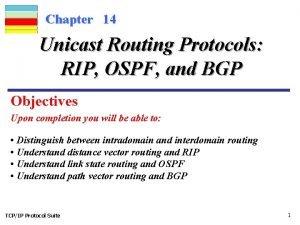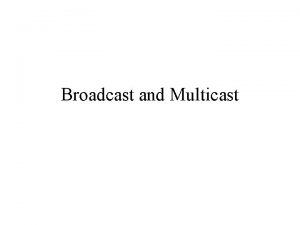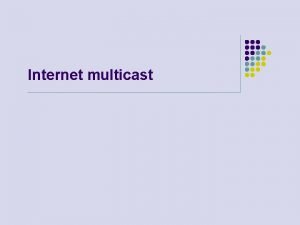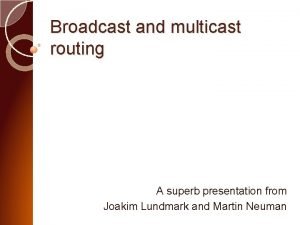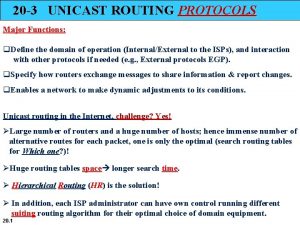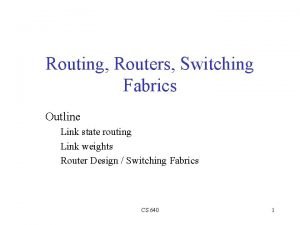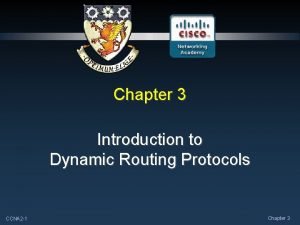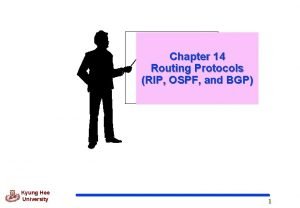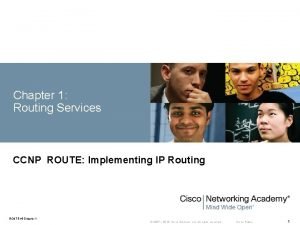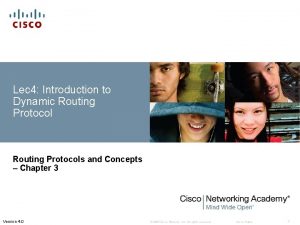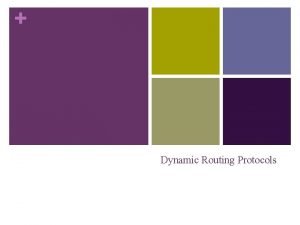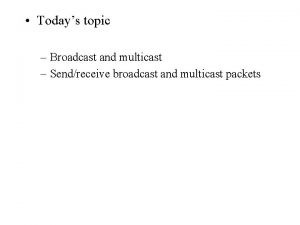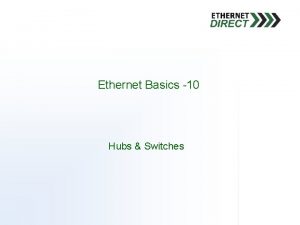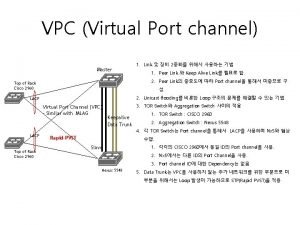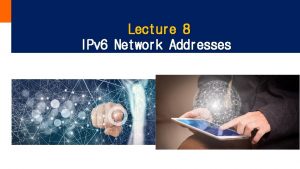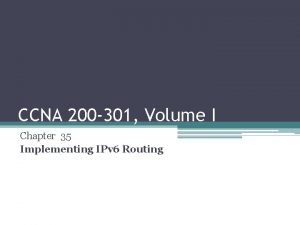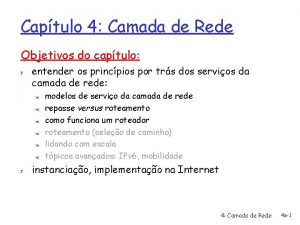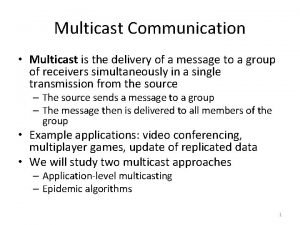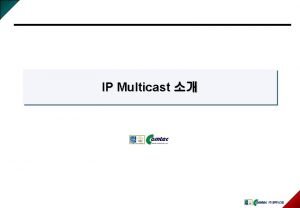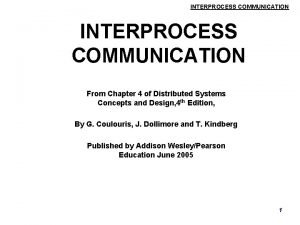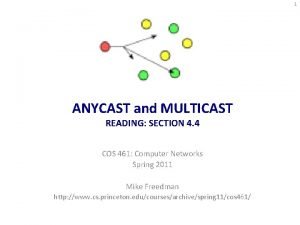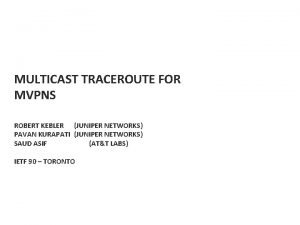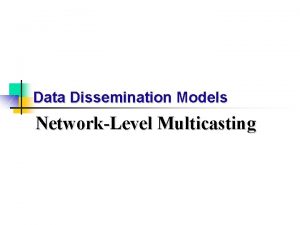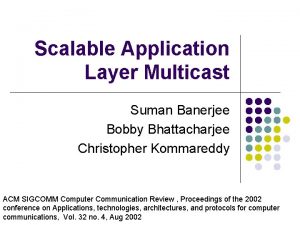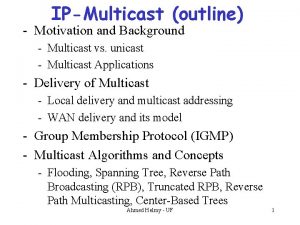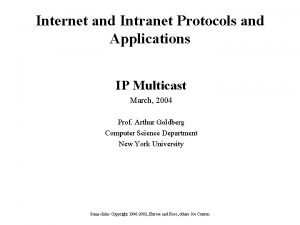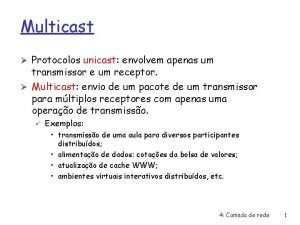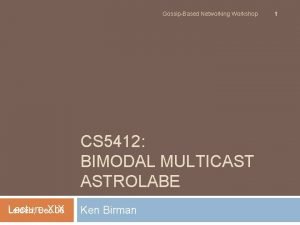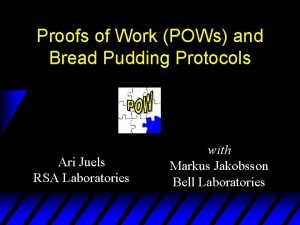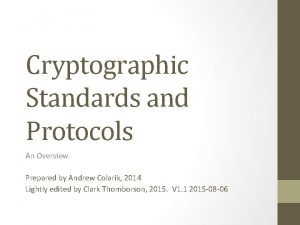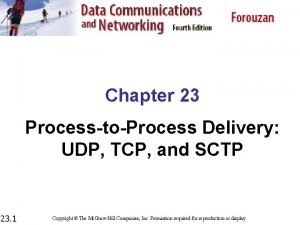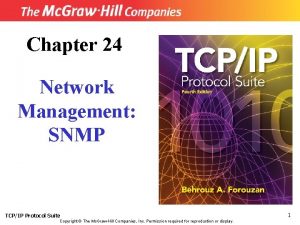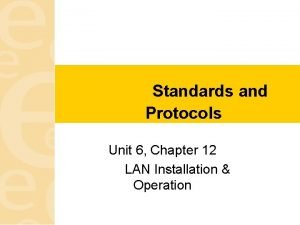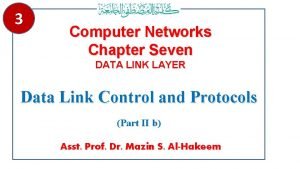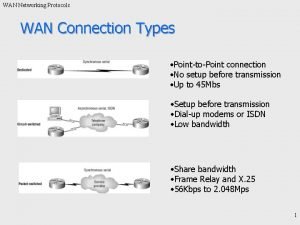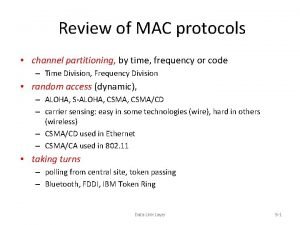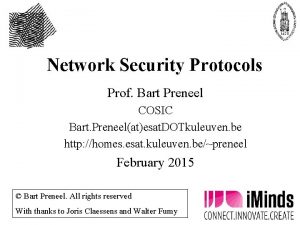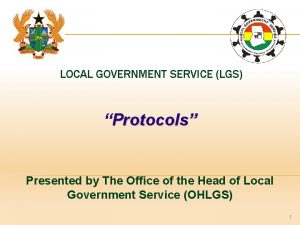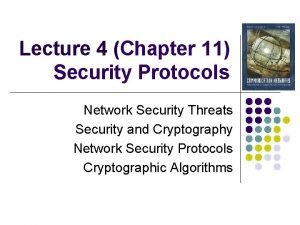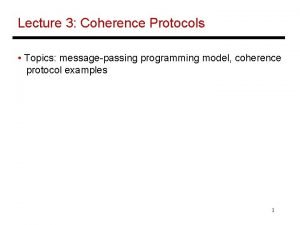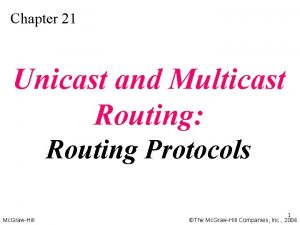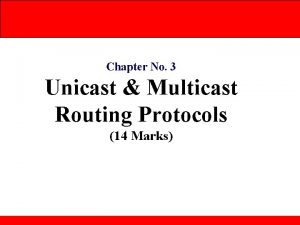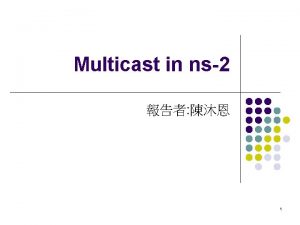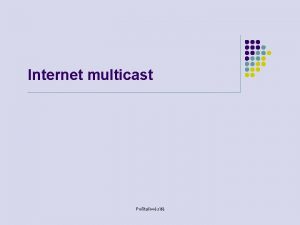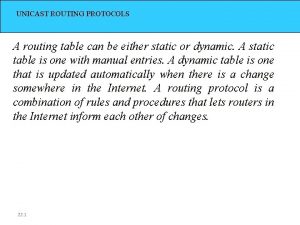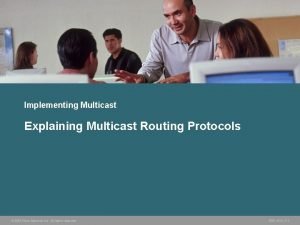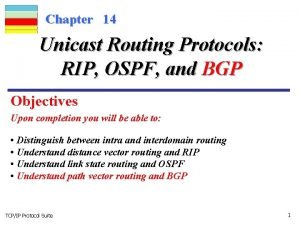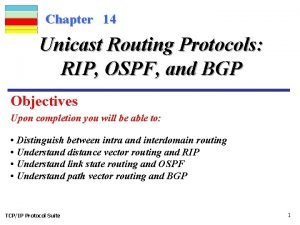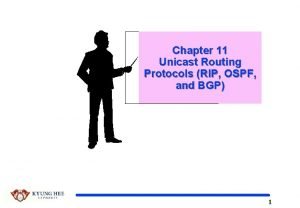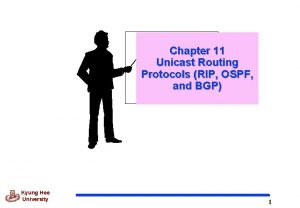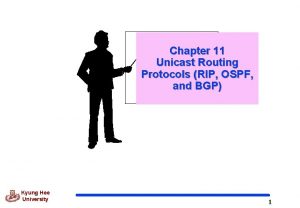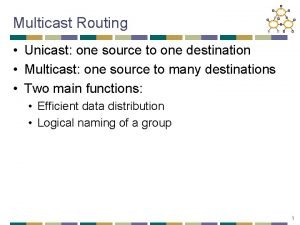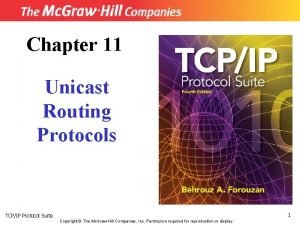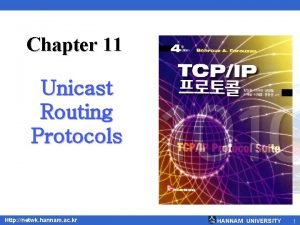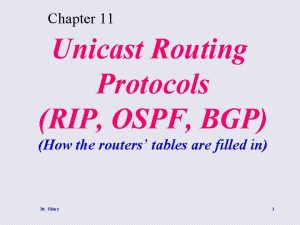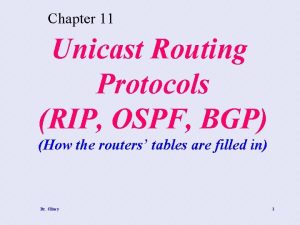Chapter 21 Unicast and Multicast Routing Routing Protocols


































































- Slides: 66

Chapter 21 Unicast and Multicast Routing: Routing Protocols Mc. Graw-Hill ©The Mc. Graw-Hill Companies, Inc. , 2004

21. 1 Unicast Routing Metric Interior and Exterior Routing Mc. Graw-Hill ©The Mc. Graw-Hill Companies, Inc. , 2004

Figure 21. 1 Unicasting Mc. Graw-Hill ©The Mc. Graw-Hill Companies, Inc. , 2004

Note: In unicast routing, the router forwards the received packet through only one of its ports. Mc. Graw-Hill ©The Mc. Graw-Hill Companies, Inc. , 2004

21. 2 Unicast Routing Protocols RIP OSPF BGP Mc. Graw-Hill ©The Mc. Graw-Hill Companies, Inc. , 2004

Figure 21. 2 Popular routing protocols Mc. Graw-Hill ©The Mc. Graw-Hill Companies, Inc. , 2004

Figure 21. 3 Autonomous systems Mc. Graw-Hill ©The Mc. Graw-Hill Companies, Inc. , 2004

Table 21. 1 A distance vector routing table Destination Hop Count Next Router 163. 5. 0. 0 7 172. 6. 23. 4 197. 5. 13. 0 5 176. 3. 6. 17 189. 45. 0. 0 4 200. 5. 1. 6 115. 0. 0. 0 6 131. 4. 7. 19 Mc. Graw-Hill Other information ©The Mc. Graw-Hill Companies, Inc. , 2004

RIP Updating Algorithm Receive: a response RIP message 1. Add one hop to the hop count for each advertised destination. 2. Repeat the following steps for each advertised destination: 1. If (destination not in the routing table) 1. Add the advertised information to the table. 2. Else 1. If (next-hop field is the same) 1. Replace entry in the table with the advertised one. 2. Else 1. If (advertised hop count smaller than one in the table) 1. Replace entry in the routing table. 3. Return. Mc. Graw-Hill ©The Mc. Graw-Hill Companies, Inc. , 2004

Figure 21. 4 Example of updating a routing table Mc. Graw-Hill ©The Mc. Graw-Hill Companies, Inc. , 2004

Figure 21. 5 Initial routing tables in a small autonomous system Mc. Graw-Hill ©The Mc. Graw-Hill Companies, Inc. , 2004

Figure 21. 6 Final routing tables for Figure 21. 5 Mc. Graw-Hill ©The Mc. Graw-Hill Companies, Inc. , 2004

Figure 21. 7 Areas in an autonomous system Mc. Graw-Hill ©The Mc. Graw-Hill Companies, Inc. , 2004

Figure 21. 8 Types of links Mc. Graw-Hill ©The Mc. Graw-Hill Companies, Inc. , 2004

Figure 21. 9 Point-to-point link Mc. Graw-Hill ©The Mc. Graw-Hill Companies, Inc. , 2004

Figure 21. 10 Transient link Mc. Graw-Hill ©The Mc. Graw-Hill Companies, Inc. , 2004

Figure 21. 11 Stub link Mc. Graw-Hill ©The Mc. Graw-Hill Companies, Inc. , 2004

Figure 21. 12 Example of an internet Mc. Graw-Hill ©The Mc. Graw-Hill Companies, Inc. , 2004

Figure 21. 13 Graphical representation of an internet Mc. Graw-Hill ©The Mc. Graw-Hill Companies, Inc. , 2004

Figure 21. 14 Types of LSAs Mc. Graw-Hill ©The Mc. Graw-Hill Companies, Inc. , 2004

Figure 21. 15 Router link Mc. Graw-Hill ©The Mc. Graw-Hill Companies, Inc. , 2004

Figure 21. 16 Network link Mc. Graw-Hill ©The Mc. Graw-Hill Companies, Inc. , 2004

Figure 21. 17 Summary link to network Mc. Graw-Hill ©The Mc. Graw-Hill Companies, Inc. , 2004

Figure 21. 18 Summary link to AS boundary router Mc. Graw-Hill ©The Mc. Graw-Hill Companies, Inc. , 2004

Figure 21. 19 External link Mc. Graw-Hill ©The Mc. Graw-Hill Companies, Inc. , 2004

Note: In OSPF, all routers have the same link state database. Mc. Graw-Hill ©The Mc. Graw-Hill Companies, Inc. , 2004

Dijkstra Algorithm 1. 2. 3. 4. 5. Start with the local node (router): the root of the tree. Assign a cost of 0 to this node and make it the first permanent node. Examine each neighbor node of the node that was the last permanent node. Assign a cumulative cost to each node and make it tentative. Among the list of tentative nodes 1. Find the node with the smallest cumulative cost and make it permanent. 2. If a node can be reached from more than one direction 1. Select the direction with the shortest cumulative cost. 6. Repeat steps 3 to 5 until every node becomes permanent. Mc. Graw-Hill ©The Mc. Graw-Hill Companies, Inc. , 2004

Figure 21. 20 Shortest-path calculation Mc. Graw-Hill ©The Mc. Graw-Hill Companies, Inc. , 2004

Table 21. 2 Link state routing table for router A Mc. Graw-Hill Network Cost Next Router N 1 5 C N 2 7 D N 3 10 B N 4 11 D N 5 15 C Other Information ©The Mc. Graw-Hill Companies, Inc. , 2004

Table 21. 3 Path vector routing table Mc. Graw-Hill Network Next Router Path N 01 R 01 AS 14, AS 23, AS 67 N 02 R 05 AS 22, AS 67, AS 05, AS 89 N 03 R 06 AS 67, AS 89, AS 09, AS 34 N 04 R 12 AS 62, AS 09 ©The Mc. Graw-Hill Companies, Inc. , 2004

Figure 21. 21 Path vector messages Mc. Graw-Hill ©The Mc. Graw-Hill Companies, Inc. , 2004

Figure 21. 22 Types of BGP messages Mc. Graw-Hill ©The Mc. Graw-Hill Companies, Inc. , 2004

21. 3 Multicast Routing IGMP Multicast Trees MBONE Mc. Graw-Hill ©The Mc. Graw-Hill Companies, Inc. , 2004

Figure 21. 23 Multicasting Mc. Graw-Hill ©The Mc. Graw-Hill Companies, Inc. , 2004

Note: In multicast routing, the router may forward the received packet through several of its ports. Mc. Graw-Hill ©The Mc. Graw-Hill Companies, Inc. , 2004

Note: IGMP is a group management protocol. It helps a multicast router create and update a list of loyal members related to each router interface. Mc. Graw-Hill ©The Mc. Graw-Hill Companies, Inc. , 2004

Figure 21. 24 IGMP message types Mc. Graw-Hill ©The Mc. Graw-Hill Companies, Inc. , 2004

Figure 21. 25 IGMP message format Mc. Graw-Hill ©The Mc. Graw-Hill Companies, Inc. , 2004

Table 21. 4 IGMP type field Type Value General or special query 0 x 11 or 0001 Membership report 0 x 16 or 00010110 Leave report 0 x 17 or 00010111 Mc. Graw-Hill ©The Mc. Graw-Hill Companies, Inc. , 2004

Figure 21. 26 IGMP operation Mc. Graw-Hill ©The Mc. Graw-Hill Companies, Inc. , 2004

Figure 21. 27 Membership report Mc. Graw-Hill ©The Mc. Graw-Hill Companies, Inc. , 2004

Note: In IGMP, a membership report is sent twice, one after the other. Mc. Graw-Hill ©The Mc. Graw-Hill Companies, Inc. , 2004

Figure 21. 28 Leave report No Response Mc. Graw-Hill ©The Mc. Graw-Hill Companies, Inc. , 2004

Note: The general query message does not define a particular group. Mc. Graw-Hill ©The Mc. Graw-Hill Companies, Inc. , 2004

Figure 21. 29 General query message No Response Mc. Graw-Hill ©The Mc. Graw-Hill Companies, Inc. , 2004

Example 1 Imagine there are three hosts in a network, as shown in Figure 21. 30 (below). A query message was received at time 0; the random delay time (in tenths of seconds) for each group is shown next to the group address. Show the sequence of report messages. Mc. Graw-Hill ©The Mc. Graw-Hill Companies, Inc. , 2004

Solution The events occur in this sequence: 1. 2. 3. 4. Time 12. The timer for 228. 42. 0. 0 in host A expires and a membership report is sent, which is received by the router and every host including host B which cancels its timer for 228. 42. 0. 0. Time 30. The timer for 225. 14. 0. 0 in host A expires and a membership report is sent, which is received by the router and every host including host C which cancels its timer for 225. 14. 0. 0. Time 50. The timer for 251. 71. 0. 0 in host B expires and a membership report is sent, which is received by the router and every host. Time 70. The timer for 230. 43. 0. 0 in host C expires and a membership report is sent, which is received by the router and every host including host A which cancels its timer for 230. 43. 0. 0. Mc. Graw-Hill ©The Mc. Graw-Hill Companies, Inc. , 2004

Note: In a source-based tree approach, the combination of source and group determines the tree. Mc. Graw-Hill ©The Mc. Graw-Hill Companies, Inc. , 2004

Note: In the group-shared tree approach, the group determines the tree. Mc. Graw-Hill ©The Mc. Graw-Hill Companies, Inc. , 2004

Figure 21. 31 Logical tunneling Mc. Graw-Hill ©The Mc. Graw-Hill Companies, Inc. , 2004

Figure 21. 32 MBONE Mc. Graw-Hill ©The Mc. Graw-Hill Companies, Inc. , 2004

21. 4 Multicast Routing Protocols DVMRP MOSPF CBT PIM Mc. Graw-Hill ©The Mc. Graw-Hill Companies, Inc. , 2004

Figure 21. 33 Multicast routing protocols Mc. Graw-Hill ©The Mc. Graw-Hill Companies, Inc. , 2004

Figure 21. 34 Reverse path forwarding Mc. Graw-Hill ©The Mc. Graw-Hill Companies, Inc. , 2004

Note: In reverse path forwarding, the router forwards only the packets that have traveled the shortest path from the source to the router; all other copies are discarded. RPF prevents the formation of loops. Mc. Graw-Hill ©The Mc. Graw-Hill Companies, Inc. , 2004

Figure 21. 35 RPF versus RPB Mc. Graw-Hill ©The Mc. Graw-Hill Companies, Inc. , 2004

Note: RPB creates a shortest-path broadcast tree from the source to each destination. It guarantees that each destination receives one and only one copy of the packet. Mc. Graw-Hill ©The Mc. Graw-Hill Companies, Inc. , 2004

Figure 21. 36 RPF, RPB, and RPM Mc. Graw-Hill ©The Mc. Graw-Hill Companies, Inc. , 2004

Note: RPM adds pruning and grafting to RPB to create a multicast shortest-path tree that supports dynamic membership changes. Mc. Graw-Hill ©The Mc. Graw-Hill Companies, Inc. , 2004

Figure 21. 35 RPF versus RPB Mc. Graw-Hill ©The Mc. Graw-Hill Companies, Inc. , 2004

Figure 21. 37 Unicast tree and multicast tree Mc. Graw-Hill ©The Mc. Graw-Hill Companies, Inc. , 2004

Figure 21. 38 Shared-group tree with rendezvous router Mc. Graw-Hill ©The Mc. Graw-Hill Companies, Inc. , 2004

Figure 21. 39 Sending a multicast packet to the rendezvous router Mc. Graw-Hill ©The Mc. Graw-Hill Companies, Inc. , 2004

Note: In CBT, the source sends the multicast packet to the core router. The core router decapsulates the packet and forwards it to all interested hosts. Mc. Graw-Hill ©The Mc. Graw-Hill Companies, Inc. , 2004

Note: PIM-DM uses RPF and pruning and grafting strategies to handle multicasting. However, it is independent of the underlying unicast protocol. Mc. Graw-Hill ©The Mc. Graw-Hill Companies, Inc. , 2004

Note: PIM-SM is similar to CBT but uses a simpler procedure. Mc. Graw-Hill ©The Mc. Graw-Hill Companies, Inc. , 2004
 Write a detailed note on unicast routing protocols
Write a detailed note on unicast routing protocols Unicast multicast broadcast
Unicast multicast broadcast Unicast vs multicast vs broadcast
Unicast vs multicast vs broadcast Unicast multicast broadcast address example
Unicast multicast broadcast address example Broadcast vs unicast
Broadcast vs unicast Unicast vs multicast
Unicast vs multicast Broadcast and multicast routing
Broadcast and multicast routing What is unicast routing
What is unicast routing Lab 4-1: routing concepts and protocols
Lab 4-1: routing concepts and protocols Routing fabric
Routing fabric 325181028 routing
325181028 routing Inter vlan routing layer 3 switch
Inter vlan routing layer 3 switch Routing protocols administrative distance
Routing protocols administrative distance Rip vs ospf vs bgp
Rip vs ospf vs bgp Routing protocols administrative distance
Routing protocols administrative distance Introduction to dynamic routing protocols
Introduction to dynamic routing protocols Routing protocols
Routing protocols Goodrich method is used for
Goodrich method is used for Mark tinka
Mark tinka Continuity equation hydrology
Continuity equation hydrology Routing in physical design
Routing in physical design Chapter 3 network protocols and communications
Chapter 3 network protocols and communications Broadcasting
Broadcasting Luoyi fu
Luoyi fu Port2port
Port2port Unicast flooding
Unicast flooding Unicast
Unicast Unicast
Unicast Floating static route
Floating static route Global unicast
Global unicast What is a characteristic of multicast messages
What is a characteristic of multicast messages What is multicast communication in distributed system
What is multicast communication in distributed system Rfp check
Rfp check Request reply protocol in distributed system
Request reply protocol in distributed system Anycast vs multicast
Anycast vs multicast Robert kebler
Robert kebler Overlay multicast
Overlay multicast Multicast
Multicast Order of events
Order of events Multicast
Multicast Multicast
Multicast Multicast
Multicast Multicast
Multicast Multicast roteador
Multicast roteador Bier multicast
Bier multicast Bimodal multicast
Bimodal multicast Calico multicast
Calico multicast Proofs of work and bread pudding protocols
Proofs of work and bread pudding protocols Wan technologies overview
Wan technologies overview Cryptography standards and protocols
Cryptography standards and protocols Tcp and sctp are both layer protocols
Tcp and sctp are both layer protocols 5 network topologies
5 network topologies Snmp uses two other protocols and
Snmp uses two other protocols and Lan standards and protocols
Lan standards and protocols Data link layer protocols for noisy and noiseless channels
Data link layer protocols for noisy and noiseless channels Plc norms
Plc norms Protocols and standards in computer networks
Protocols and standards in computer networks Network protocols map
Network protocols map Elementary data link protocols
Elementary data link protocols Channel partitioning mac protocols
Channel partitioning mac protocols Presentation layer
Presentation layer Network security protocols
Network security protocols Local government service protocols
Local government service protocols Network security protocols
Network security protocols Cache coherence protocols
Cache coherence protocols Wireless sensor network protocols
Wireless sensor network protocols Define nursing protocols
Define nursing protocols
